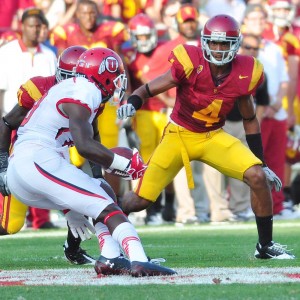USC looks to amend fourth quarter woes
One of the common criticisms levied against USC last season was its almost weekly fourth quarter drop-offs, failing to stave off opponents in the final minutes.

Lights out · Redshirt sophomore cornerback Torin Harris intercepted a pass to seal the game against Minnesota in USC’s 19-17 home-opener win. Against Utah, Harris returned a blocked field goal for a touchdown to clinch the Trojans’ 23-14 victory. - Carlo Acenas | Daily Trojan
Whether it was Stanford quarterback Andrew Luck toying with a leaky USC pass defense or former wide receiver Ronald Johnson dropping a potential game-winning touchdown pass against Notre Dame, USC often fell short in 2010, as three of its five losses came within a double-digit margin.
Perhaps most telling, though, is that at no point did the Trojans win a game in which they trailed entering the fourth quarter. They did, however, wind up losing three games in which they were leading or tied at the beginning of the final period.
All told, USC’s point differential in the fourth quarter last season was minus-46. Conversely, it outscored its opponents by a 102-point margin in the first three quarters.
Through two games in 2011, that trend hasn’t changed, as USC possesses a minus-one point differential in the fourth quarter before playing, arguably, any of its top five opponents this season.
After Saturday’s game, USC coach Lane Kiffin offered a brief explanation for the lack of offensive productivity in the second halves of the Trojans’ first two games.
“The bottom line is to win the game, so in the fourth quarters of these games, we have had the lead and we’ve called the game to win the game,” Kiffin said. “We haven’t called the game for stats, so we’ve been very conservative in those times.”
Some of the criticism for a lack of fourth quarter production this season has centered on junior quarterback Matt Barkley.
In the final period, Barkley is a mere 8-for-15 for 64 yards with no touchdowns and no interceptions — his worst quarter statistically. Such a performance has prompted the question of whether Kiffin has been too conservative in his playcalling when the game is on the line.
“He hasn’t been behind yet,” Kiffin said of the Trojans’ third-year signal caller. “That’s really where the issue comes up. When you’re behind you got to move them so we’ve been very conservative with our calls to make sure we win the game and not worry about stats.”
Rewind to 2010, and Barkley had a 45.5 percent completion rate in the fourth quarter with a 3:2 touchdown-to-interception ratio. In 2009, he sported a 50.7 percent completion rate with a ghastly 1:7 ratio.
“It’s frustrating because I know that we’re capable of so much more, but we just shoot ourselves in the foot,” Barkley said.
Moving forward, though, Barkley has remains optimistic.
“We’ve had glimpses of what we’re capable of in the first half of most games,” Barkley said. “Being able to put that into whole halves this week is what we’re trying to do.”
Though not pointing to any one thing in particular, Barkley noted the offense can improve in many areas.
“I think it’s a lot of things, unfortunately,” he said. “But it ultimately comes down to execution, guys focusing and not losing that mentality we have in the first half.”
The return of senior tailback Marc Tyler, who debuted against Utah, should add an additional element to the offense. Against the Utes, Tyler rushed for 24 carries for 113 yards and one touchdown.
“I thought Marc played well, especially for missing the majority of camp and going in there,” Kiffin said. “So the good thing is hopefully he’ll improve on that.”
An encouraging development thus far has been the defense’s ability to pick up the offense’s slack.
USC’s pass defense struggled often in 2010, particularly in the fourth quarter, surrendering 13 of the 30 total passing touchdowns it gave up last season in the final period. Opposing quarterbacks were able to complete 63.7 percent of their passes for 947 yards. USC’s defense also allowed opponents to pick up 5.22 yards per rush.
In 2011, however, USC has allowed its opponents to complete only 40.7 percent of its passes for one touchdown and one interception. The rush defense has been impressively stout, surrendering 0.8 yards per attempt.
The goal moving forward, at least, according to Barkley is to get both units clicking at the same time.
“I feel like we need to keep that rhythm that we have in the first half,” Barkley said. “It’s just due to mental mistakes. I can do a better job of telling my teammates, especially the 11 that are in, just keep them focused and keep them in tune with what we need to do.”

For a team to win in the second half the coach has to be able to make the better adjustments, so far Kiffin has not been that coach.